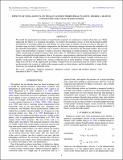Effects of Stellar Flux on Tidally Locked Terrestrial Planets: Degree-1 Mantle Convection and Local Magma Ponds
Author(s)
Gelman, S. E.; Seager, Sara; Elkins Tanton, Linda T.
DownloadSeager_Effects of Stellar.pdf (1.433Mb)
PUBLISHER_POLICY
Publisher Policy
Article is made available in accordance with the publisher's policy and may be subject to US copyright law. Please refer to the publisher's site for terms of use.
Terms of use
Metadata
Show full item recordAbstract
We model the geodynamical evolution of super-Earth exoplanets in synchronous rotation about their star. While neglecting the effects of a potential atmosphere, we explore the parameter spaces of both the Rayleigh number and intensity of incoming stellar flux, and identify two main stages of mantle convection evolution. The first is a transient stage in which a lithospheric temperature and thickness dichotomy emerges between the substellar and the antistellar hemispheres, while the style of mantle convection is dictated by the Rayleigh number. The second stage is the development of degree-1 mantle convection. Depending on mantle properties, the timescale of onset of this second stage of mantle evolution varies from order 1 to 100 billion years of simulated planetary evolution. Planets with higher Rayleigh numbers (due to, for instance, larger planetary radii than the Earth) and planets whose incoming stellar flux is high (likely for most detectable exoplanets) will develop degree-1 mantle convection most quickly, on the order of 1 billion years, which is within the age of many planetary systems. Surface temperatures range from 220 K to 830 K, implying the possibility of liquid water in some regions near the surface. These results are discussed in the context of stable molten magma ponds on hotter planets, and the habitability of super-Earths which may lie outside the Habitable Zone.
Date issued
2011-06Department
Massachusetts Institute of Technology. Department of Earth, Atmospheric, and Planetary Sciences; Massachusetts Institute of Technology. Department of PhysicsJournal
Astrophysical Journal
Publisher
IOP Publishing
Citation
Gelman, S. E., L. T. Elkins-Tanton, and S. Seager. “Effects of Stellar Flux on Tidally Locked Terrestrial Planets: Degree-1 Mantle Convection and Local Magma Ponds.” The Astrophysical Journal 735.2 (2011): 72. © 2011 IOP Publishing
Version: Final published version
ISSN
0004-6256
1538-3881